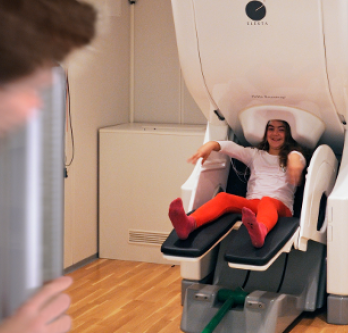We're hiring ! Join us and make a difference in our hospitals
Translational neuroimaging
Our role
The H.U.B’s Neuroimaging Department is equipped with two high-tech devices that enable us to map and study the functioning of the brain. « Our principal activity is research », explains Professor Xavier De Tiège, head of the department. « It is ‘translational’ in the sense that we aim to bring the results of our research to clinical practice, for the benefit of patients ».


The H.U.B’s Neuroimaging Department cooperates regularly with Neurosurgery, ENT, Radiology, la radiologie, Child Psychiatry, etc.
To get more info about the service : SecMed [dot] MedNuc [dot] erasme [at] hubruxelles [dot] be (SecMed[dot]MedNuc[dot]erasme[at]hubruxelles[dot]be).
Our specialities
The H.U.B’s Translational Neuroimaging Department has two leading edge technologies:
- Magnetoencephalography (MEG) records brain activity in a totally non-invasive way to a high degree of precision in terms of time (millisecond) and space (a few mm). MEG has 2 clinically recognised indications:
- to precisely pinpoint the epileptic source to be operated on in the case of refractory epilepsy;
- to precisely locate functionally important areas of the brain (for language, mobility, vision, etc.) in relation to a brain tumour or lesion that has to be operated on.
The department also contributes internationally to developing the MEG of the future based on a new sensor technology known as optical pumping magnetometers. This MEG system can be fitted directly to the scalp and offers a precision that is superior to the present system.
- PET-MRI is a technology that combines magnetic resonance imaging (MRI) and a PET-Scan. It makes it possible to visualise the brain’s anatomy and functioning simultaneously. It is very useful for studying the brain’s structure and functioning in the case of brain tumours, multiple sclerosis, cognitive disorders such as Alzheimer’s, certain learning difficulties in children, autism spectrum disorders, etc.
Our team

Our specialists
Research
The functional neuroimaging platform at the ULB – of which the Translational Neuroimaging Department and the Neuroanatomy and Neuroimaging Laboratory (LN2T) headed by Professor Xavier De Tiège are a part – enables researchers from the ULB’s Institute of Neurosciences, together with other Belgian laboratories and universities, to have access to MEG and PET-MR technology. Within the ULB itself, research relating to these two devices concentrates on its sensomotor, language and cognitive functions. It is a question of studying how and to what degree certain brain diseases (epilepsy, tumours, Alzheimer’s disease, multiple sclerosis) affect these major brain functions.
Publications
On-Scalp Magnetoencephalography Based On Optically Pumped Magnetometers Can Detect Mesial Temporal Lobe Epileptiform Discharges
- Feys O, Ferez M, Corvilain P, Schuind S, Rikir E, Legros B, Gaspard N, Holmes N, Brookes M, Wens V, De Tiège X.
- Ann Neurol. 2024 Mar;95(3):620-622.
On-Scalp Optically Pumped Magnetometers versus Cryogenic Magnetoencephalography for Diagnostic Evaluation of Epilepsy in School-aged Children
- Feys O, Corvilain P, Aeby A, Sculier C, Holmes N, Brookes M, Goldman S, Wens V, De Tiège X.
- Radiology. 2022 Aug;304(2):429-434.
Structural and metabolic brain abnormalities in COVID-19 patients with sudden loss of smell
- Niesen M, Trotta N, Noel A, Coolen T, Fayad G, Leurkin-Sterk G, Delpierre I, Henrard S, Sadeghi N, Goffard JC, Goldman S, De Tiège X.
- Eur J Nucl Med Mol Imaging. 2021 Jun;48(6):1890-1901.
Brain dysconnectivity relates to disability and cognitive impairment in multiple sclerosis
- Sjøgård M, Wens V, Van Schependom J, Costers L, D'hooghe M, D'haeseleer M, Woolrich M, Goldman S, Nagels G, De Tiège X.
- Hum Brain Mapp. 2021 Feb 15;42(3):626-643.